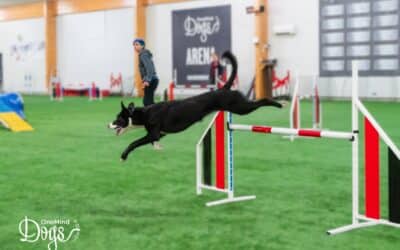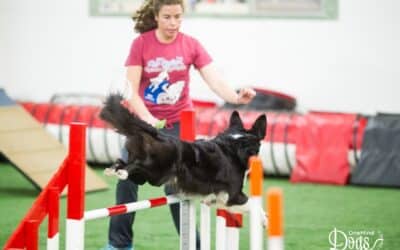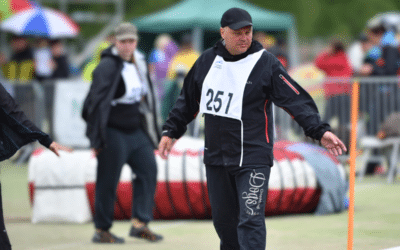At OneMind Dogs, we believe agility is about more than navigating obstacles—it’s about building an unshakable connection with your dog. Our method is rooted in seeing the course from your dog’s perspective and understanding how they naturally react to your movements.
The foundation of this approach lies in the 7 Handling Elements — the cues your dog instinctively responds to on the agility course. Mastering these elements allows you to communicate clearly and create seamless runs. Let’s explore what makes each element unique and how it contributes to the magic of teamwork.
1. Motion: The driver of your dog’s decisions on the agility course
Dogs naturally follow movement. Long before we train them, puppies instinctively chase after us when we walk away—it’s part of their nature. On the agility course, motion is your dog’s primary cue.
- What it means to your dog: Your movement tells them where to go and what to do. Accelerating encourages them to speed up, while slowing down signals the need to collect and prepare for a turn.
- Why it matters: Motion overrides other cues. If your arms or voice say “turn,” but your motion says “go straight,” your dog will follow your movement.
Understanding how to use motion effectively is like mastering the steering wheel of your dog’s agility performance.

2. Position: Your dog’s roadmap for the agility course
Your position on the course gives your dog vital information about where to turn and which obstacle to take. Dogs naturally turn toward the side where their handler is, and they align their path, and their leading leg, based on your placement.
- Key insight: Dogs can only commit to obstacles they can see while staying connected to you. If your position blocks their view, they might hesitate or miss the obstacle entirely.
- Pro tip: Choose your positions so that your dog can see both the correct obstacle and your cues at the same time.
Positioning isn’t just about where you stand—it’s about how your position supports your dog’s understanding of the course.

3. Eyes: The power of connection
Eye contact is one of the simplest yet most powerful tools for maintaining connection with your dog. Dogs naturally move toward the side you’re looking at, so your gaze plays a big role in guiding them.
- How it works: Keeping your face turned towards your dog can reassure them that you are working as a team, breaking connection is often distracting for the dog and can lead to knocked bars, badly timed take-offs or a refusal .
- Tips for success: Look directly at your dog when sending them away to obstacles or asking for collection on a turn, but shift your gaze slightly to the line ahead to maintain forward motion and stay connected when running together.
Strong eye connection helps your dog feel supported, building confidence and clarity on the course.

4. Chest Laser: Your invisible steering tool on the agility course
Imagine a laser beam projecting from your chest, pointing toward the ground in front of you. This “chest laser” is one of your dog’s most reliable cues. Dogs naturally follow the direction your chest is pointing, making it a powerful tool for steering their line and cueing changes in speed.
- What it means for agility: Turning your chest toward your dog brings them closer and cues collection, while turning it away encourages them to extend or take a wider path.
- Pro tip: Keep your chest laser aligned with your intended path to avoid mixed signals.
Consistency in your chest positioning ensures your dog understands exactly where you want them to go.

5. Feet: The easiest way to push and pull your dog’s line in agility
Your feet might not seem like a major part of handling, but to your dog, they’re a critical source of information. They are close to your dog’s head height after all! Dogs naturally watch your feet for clues about your intentions, often more than they watch your arms or hands.
- How it works: The direction of your toes and the steps you take can shape your dog’s line and help them commit to obstacles.
- Tips for success: A single step toward your dog’s line will naturally push their line out. A step away will pull the dog towards you.
Using your feet intentionally can make handling feel effortless and intuitive for your dog, even from a distance.

6. Arms and Hands: An agility cue for the handler rather than the dog
While your dog relies primarily on motion and position, your arms and hands add an extra layer of clarity to your cues because they help your body do the right thing. When you raise your off-arm for example, it naturally helps you to turn your chest.
- When to use them: Shake your hand to get your dog’s attention or extend your arm to indicate direction when sending your dog to an obstacle.
- Avoid overuse: Arms and hands should complement your other cues, not compete with them. Make sure they are subtle. You can handle your dog just as well with your arms inside a garbage bag!
By using your arms strategically, you can enhance your communication without distracting your dog.

7. Voice: Supporting your other handling elements
Verbal cues are the final piece of the puzzle. While dogs don’t naturally understand words, they can learn to associate specific sounds with actions. However, voice is most effective when it complements your body language.
- What to keep in mind: Dogs respond more strongly to body language than voice, so conflicting signals can create confusion.
- How to use it: Use verbal cues to add clarity, such as calling your dog’s name to regain their focus or using commands like “tunnel” or “jump” to support your motion and position.
Voice is like the cherry on top of your handling—it reinforces what your body is already saying.

Bringing the elements together for seamless agility runs with your dog
Each of these handling elements is powerful on its own, but the real magic happens when they work together. The key to seamless communication with your dog is ensuring all your cues align and support the same message. Learn more in our free 30-minute webinar!
For example:
- Motion drives the direction while position provides clarity.
- Connection improves your timing and accuracy
- Chest laser and feet refine the line your dog takes.
- Arms and voice add emphasis when needed.
When these elements are consistent, your dog doesn’t have to guess—they can simply follow your lead.
Why perspective is important in dog agility
The OneMind Dogs method isn’t just about learning techniques—it’s about understanding your dog’s perspective. By seeing the course through their eyes, you can make informed choices that set them up for success.
This approach doesn’t just improve your agility runs—it strengthens your bond, builds trust, and makes training more enjoyable for both you and your dog.
Want to Learn More?
The 7 Handling Elements are just the beginning of what’s possible with the OneMind Dogs method. Whether you’re new to agility or a seasoned competitor, there’s always more to discover about how your dog naturally interprets your cues.
Ready to take the next step? Explore our training programs and resources to unlock the full potential of your agility journey—from your dog’s perspective.
Because when you understand your dog, agility becomes effortless—and so much more fun.



